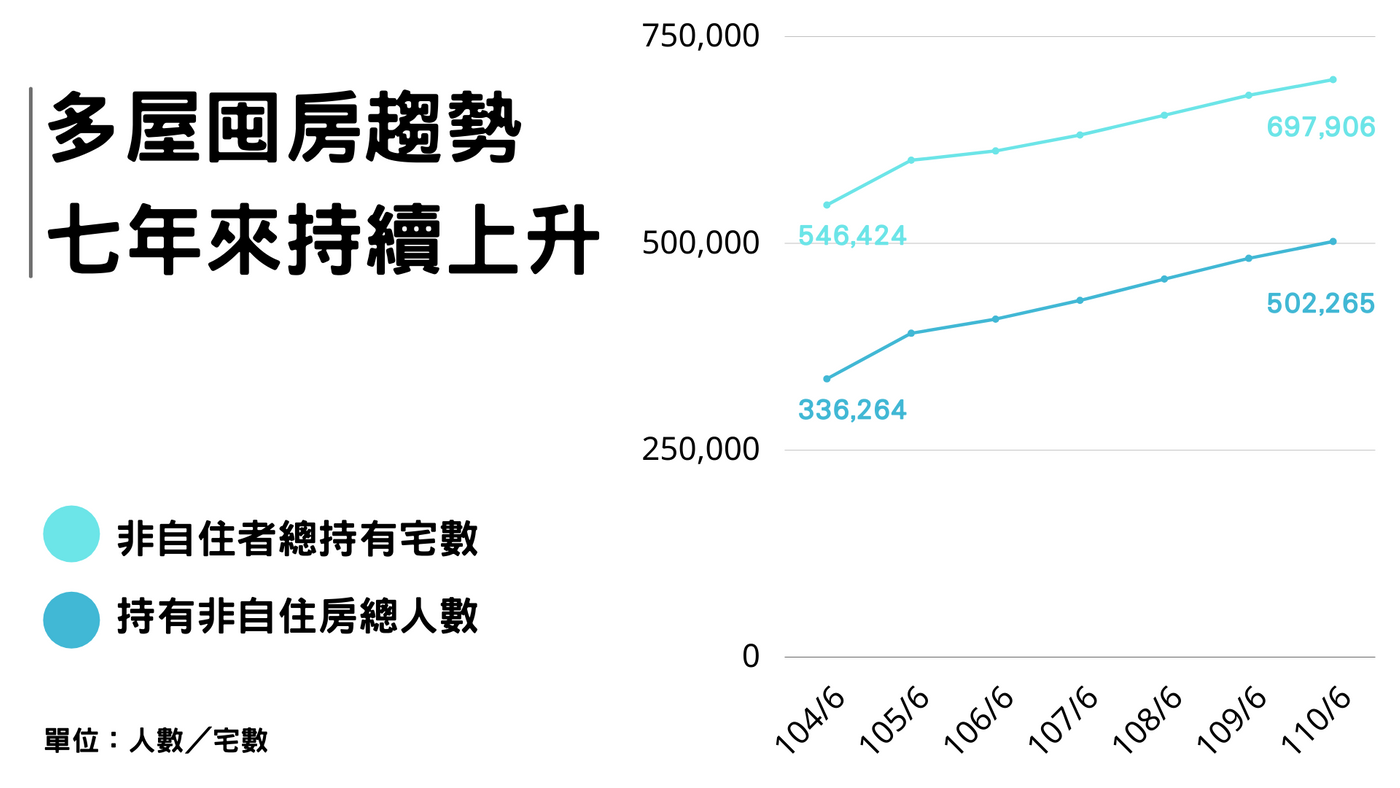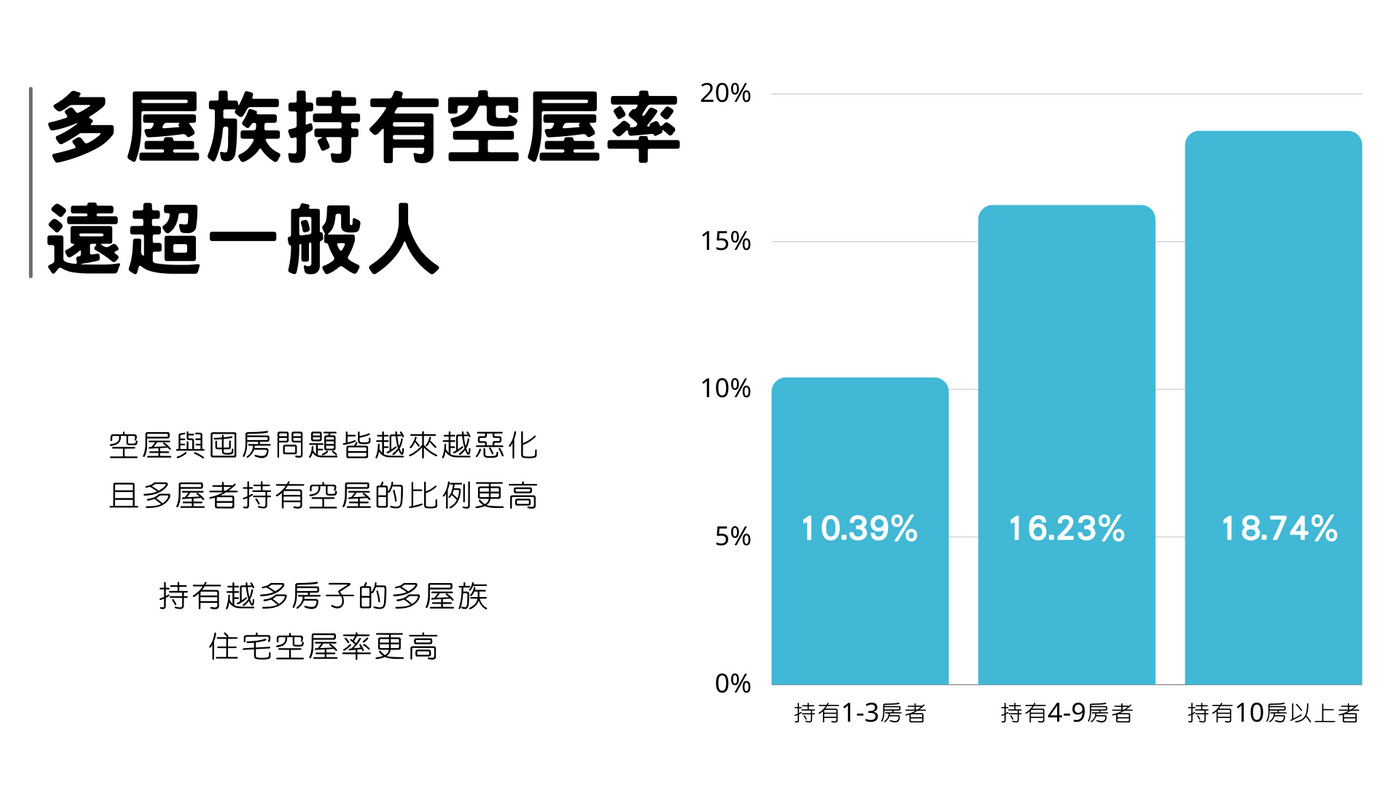
台灣居住政策研究;社會住宅推動聯盟研究員。 這邊都是有關居住正義的硬核文章,偶爾有幾篇沒那麼硬的。 贊助連結:https://liker.land/limitroy/civic FB:https://www.facebook.com/limitroy/
Empty houses and hoarded houses are both deteriorating, and the government is still whitewashing the peace
Link to the full text of Naruto: https://reurl.cc/V53MN5
I believe everyone can see how the housing justice has achieved in the past two years and how the housing price has been. With the continuous tracking and assistance of legislators, we have tracked down some data.
Let’s start with the conclusion. From the existing data, we can see the following three phenomena:
1. The number of vacant houses in Taiwan hit a new high, and the problem of vacant houses is more serious than the data presented in the past.
2. There is a more and more serious trend of housing hoarding, and the current data is still the result of conservative estimates.
3. Hoarding houses is closely related to vacant houses. The proportion of vacant houses held by multi-family households is higher, and the vacancy rate of new houses and legal persons is particularly high.
[Empty house: The problem is more serious than imagined]
I posted about this topic two days ago. According to the preliminary analysis of the 2020 population and housing census, although the vacancy rate has dropped slightly (18.5%), the overall number of vacant houses has reached 1.664 million, which has broken a record high. The record far surpassed the 882,000 homes in the 2020 low-use residential survey.
Even if the type of "occasional self-occupation" is excluded, the number of vacant houses in Taiwan is 1.175 million (the vacancy rate is 13.1%), which is still larger than the number of low-use residential surveys, and the survey of low-use residential buildings has not been excluded statistically. "occasionally live in" type. Therefore, in the past, there was a long-term and serious underestimation of the data on vacant houses in Taiwan, and the vacant house problem was more serious than imagined.

[Hoarding: It has risen for seven consecutive years]
"Statistics on non-owner-occupied residences" can be regarded as preliminary evidence of the "growth trend of multi-family households in Taiwan" (but it is still inaccurate, see the full text), and the available data show that the number of individuals holding non-owner-occupied residences in Taiwan has increased from the 104-year 336,000 people rose to 502,000 in 2011, and the number of "non-self-occupied residences" they held rose from 546,000 to 697,000. It can be seen that "the number of people who own multiple houses is on the rise", that is, real estate in Taiwan. The trend of centralization is gradually obvious. If the data held by individuals is returned to the household as household data, the degree of centralization of real estate will be more obvious.
The hoarding situation of natural persons is becoming more and more serious, and the hoarding of legal persons is not better. According to a press release issued by the Ministry of the Interior in March this year, for legal persons in the “non-real estate and construction engineering industry” (excluding builders who may hold surplus houses), 8.73% of these legal persons own multiple houses (more than four bedrooms), but Holds 68.06% of the residences owned by such legal persons. Except for a few used as staff dormitories, the proportion of a few legal persons with multiple houses is so high, which is likely to be a tax avoidance investment through the operation of legal persons.

[Multiple families love vacant houses, and they all buy new houses to be vacant]
Statistics show that in 2010, the vacancy rate of residential houses held by natural persons with one to three rooms was 10.39%, 16.23% with four to nine rooms, and 18.74% with more than ten rooms. That is to say, the proportion of vacant homes held by multi-family dwellers is the highest, and the more dwellings who own more houses, the higher the vacancy rate of their dwellings.
This statistic also analyzes the age of vacant houses. Among them, the vacancy rate of newly built houses “less than five years old” is the highest, with an average of more than 30%. If compared with the number of houses held, one to three houses are held. The vacancy rate for homes with less than five years’ duration was 32.08%, 42.95% for four to nine bedrooms, and 61.98% for homes with ten or more bedrooms.
This data makes some of the arguments against the hoarding tax in the past, such as "one-households hold the highest rate of vacant houses", "vacant houses are mostly rural ancestral houses" and other arguments are self-defeating. Even due to the extremely high vacancy rate of newly built homes, the industry and the government’s assertion that “Taiwan’s housing prices are high means rigid demand is still large” has been challenged: if the vacancy rate of newly built homes is so high in recent years, investment demand is likely to be real estate The main driver of the market.

[The problem of hoarding and empty houses is becoming more and more clear, and the government should actively propose countermeasures]
In the past, the government adopted an attitude of "denying the problem" in the face of issues such as housing hoarding and the reform of the holding tax system, and even issued a press release saying that "the problem of housing hoarding in Taiwan is limited." The problem of hoarding houses is indeed becoming more and more serious, and it has caused serious vacancy and waste of residential resources, and has even become a hotbed of speculation.
At the public hearing in March 2021, the Ministry of Finance has promised to evaluate the housing hoarding tax. Half a year later, relevant countermeasures and more accurate information are still lacking. The government should face up to the soaring housing prices and the unreasonable holding tax system, and actively research and propose the Executive Yuan version of the housing tax plan.
Like my work?
Don't forget to support or like, so I know you are with me..
Comment…